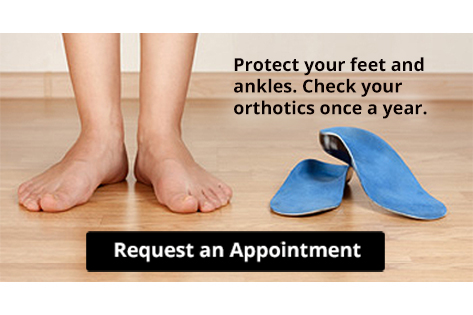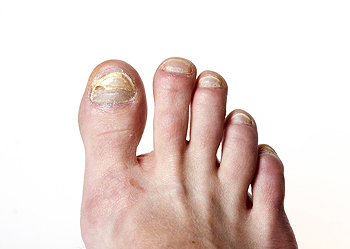December 2019
How Do Broken Toes Occur?
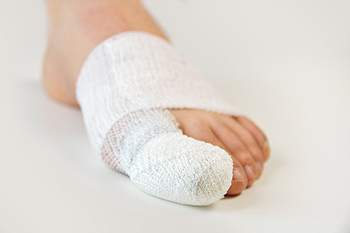 A broken toe can be the result of a heavy object falling on it, or jamming it against a piece of furniture. Common symptoms that are typically associated with this ailment can consist of severe pain and discomfort, extreme bruising, and difficulty walking. A diagnosis is typically performed by having an X-ray taken. This is an effective method in locating the exact area of the toe where the fracture has occurred. Once this has been determined, the correct treatment can begin. Many patients find it beneficial to tape the affected toe to the toe next to it. This is known as the buddy taping method. Additionally, for severe fractures, it may help to wear a boot that can offer adequate support as the toe begins to heal. If you have broken your toe, it is advised that you seek the counsel of a podiatrist who can help you to choose the best treatment option.
A broken toe can be the result of a heavy object falling on it, or jamming it against a piece of furniture. Common symptoms that are typically associated with this ailment can consist of severe pain and discomfort, extreme bruising, and difficulty walking. A diagnosis is typically performed by having an X-ray taken. This is an effective method in locating the exact area of the toe where the fracture has occurred. Once this has been determined, the correct treatment can begin. Many patients find it beneficial to tape the affected toe to the toe next to it. This is known as the buddy taping method. Additionally, for severe fractures, it may help to wear a boot that can offer adequate support as the toe begins to heal. If you have broken your toe, it is advised that you seek the counsel of a podiatrist who can help you to choose the best treatment option.
A broken toe can be very painful and lead to complications if not properly fixed. If you have any concerns about your feet, contact Dr. Lee R. Stein from Lake Shore Foot & Ankle, PC. Our doctor will treat your foot and ankle needs.
What to Know About a Broken Toe
Although most people try to avoid foot trauma such as banging, stubbing, or dropping heavy objects on their feet, the unfortunate fact is that it is a common occurrence. Given the fact that toes are positioned in front of the feet, they typically sustain the brunt of such trauma. When trauma occurs to a toe, the result can be a painful break (fracture).
Symptoms of a Broken Toe
- Throbbing pain
- Swelling
- Bruising on the skin and toenail
- The inability to move the toe
- Toe appears crooked or disfigured
- Tingling or numbness in the toe
Generally, it is best to stay off of the injured toe with the affected foot elevated.
Severe toe fractures may be treated with a splint, cast, and in some cases, minor surgery. Due to its position and the pressure it endures with daily activity, future complications can occur if the big toe is not properly treated.
If you have any questions please feel free to contact one of our offices located in Chicago, Highland Park, and Uptown, IL . We offer the newest diagnostic and treatment technologies for all your foot and ankle needs.
Why Are My Feet Swollen?
 Many women are aware of the numerous aches and pains the body may experience throughout pregnancy. A common area for pain to occur is in the feet. This may be caused by the additional weight that builds during pregnancy, which may affect the arch, causing it to either disappear in the feet, or become extremely low. The feet may roll inward as a result of flat feet, and this may cause significant pain. Relief may be found when appropriate shoes are worn, and it may help to wear custom orthotics. Another common ailment that many pregnant women experience is swollen feet. This happens as a result of increased fluids and blood volume. To lessen the swelling, it may help to avoid foods that have elevated levels of salt, elevate the legs as often as possible, and wear shoes that fit correctly. If you have any questions about how pregnancy can affect the feet, it is suggested that you consult with a podiatrist.
Many women are aware of the numerous aches and pains the body may experience throughout pregnancy. A common area for pain to occur is in the feet. This may be caused by the additional weight that builds during pregnancy, which may affect the arch, causing it to either disappear in the feet, or become extremely low. The feet may roll inward as a result of flat feet, and this may cause significant pain. Relief may be found when appropriate shoes are worn, and it may help to wear custom orthotics. Another common ailment that many pregnant women experience is swollen feet. This happens as a result of increased fluids and blood volume. To lessen the swelling, it may help to avoid foods that have elevated levels of salt, elevate the legs as often as possible, and wear shoes that fit correctly. If you have any questions about how pregnancy can affect the feet, it is suggested that you consult with a podiatrist.
Pregnant women with swollen feet can be treated with a variety of different methods that are readily available. For more information about other cures for swollen feet during pregnancy, consult with Dr. Lee R. Stein from Lake Shore Foot & Ankle, PC. Our doctor will attend to all of your foot and ankle needs.
What Foot Problems Can Arise During Pregnancy?
One problem that can occur is overpronation, which occurs when the arch of the foot flattens and tends to roll inward. This can cause pain and discomfort in your heels while you’re walking or even just standing up, trying to support your baby.
Another problem is edema, or swelling in the extremities. This often affects the feet during pregnancy but tends to occur in the later stages.
How Can I Keep My Feet Healthy During Pregnancy?
- Wearing orthotics can provide extra support for the feet and help distribute weight evenly
- Minimize the amount of time spent walking barefoot
- Wear shoes with good arch support
- Wear shoes that allow for good circulation to the feet
- Elevate feet if you experience swelling
- Massage your feet
- Get regular, light exercise, such as walking, to promote blood circulation to the feet
If you have any questions please feel free to contact one of our offices located in Chicago, Highland Park, and Uptown, IL . We offer the newest diagnostic and treatment technologies for all your foot and ankle needs.
Possible Causes of Blisters
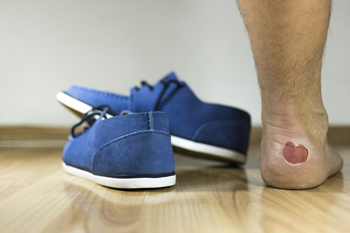 The most common cause of blisters on the feet is friction. This can happen as a result of wearing shoes and socks that do not fit correctly. Additionally, there may be other circumstances that can cause blisters. These can consist of an allergic reaction to an insect bite, severe sunburn, or medical conditions such as dermatitis. A blister will generally form as the body’s natural reaction to protect skin that has been damaged. It appears as a bubble that is filled with fluid, and will gradually drain when the new skin forms. It may help to wear an elastic bandage over the blister, which can help to protect the area as daily activities are accomplished. If you have a blister on your foot that has become infected, it is advised that you consult with a podiatrist who can offer treatment solutions.
The most common cause of blisters on the feet is friction. This can happen as a result of wearing shoes and socks that do not fit correctly. Additionally, there may be other circumstances that can cause blisters. These can consist of an allergic reaction to an insect bite, severe sunburn, or medical conditions such as dermatitis. A blister will generally form as the body’s natural reaction to protect skin that has been damaged. It appears as a bubble that is filled with fluid, and will gradually drain when the new skin forms. It may help to wear an elastic bandage over the blister, which can help to protect the area as daily activities are accomplished. If you have a blister on your foot that has become infected, it is advised that you consult with a podiatrist who can offer treatment solutions.
Blisters may appear as a single bubble or in a cluster. They can cause a lot of pain and may be filled with pus, blood, or watery serum. If your feet are hurting, contact Dr. Lee R. Stein of Lake Shore Foot & Ankle, PC. Our doctor can provide the care you need to keep you pain-free and on your feet.
Foot Blisters
Foot blisters are often the result of friction. This happens due to the constant rubbing from shoes, which can lead to pain.
What Are Foot Blisters?
A foot blister is a small fluid-filled pocket that forms on the upper-most layer of the skin. Blisters are filled with clear fluid and can lead to blood drainage or pus if the area becomes infected.
Symptoms
(Blister symptoms may vary depending on what is causing them)
- Bubble of skin filled with fluid
- Redness
- Moderate to severe pain
- Itching
Prevention & Treatment
In order to prevent blisters, you should be sure to wear comfortable shoes with socks that cushion your feet and absorb sweat. Breaking a blister open may increase your chances of developing an infection. However, if your blister breaks, you should wash the area with soap and water immediately and then apply a bandage to the affected area. If your blisters cause severe pain it is important that you call your podiatrist right away.
If you have any questions, please feel free to contact one of our offices located in Chicago, Highland Park, and Uptown, IL . We offer the newest diagnostic and treatment technologies for all your foot care needs.
Reminder: When Was the Last Time...?
Contagious Toenail Fungus
Toenail fungus is typically caused by a nail infection. The medical term for this type of fungus is known as onychomycosis. Common symptoms can include thicker nails, nail discoloration, and in severe cases, the nail may split. Patients may notice pain when the affected nail is pressing against the inside of the shoe. The fungus that causes this type of infection thrives in warm and moist environments that can include shower and locker room floors, and public pools. It may help to wear appropriate shoes while in these areas, and this may be beneficial in preventing this infection. People who are diabetic, obese, or have a family history of toenail fungus may be more susceptible to developing toenail fungus. If you notice symptoms of this condition, it is suggested that you consult with a podiatrist who can offer proper treatment options.
If left untreated, toenail fungus may spread to other toenails, skin, or even fingernails. If you suspect you have toenail fungus it is important to seek treatment right away. For more information about treatment, contact Dr. Lee R. Stein of Lake Shore Foot & Ankle, PC. Our doctor can provide the care you need to keep you pain-free and on your feet.
Symptoms
- Warped or oddly shaped nails
- Yellowish nails
- Loose/separated nail
- Buildup of bits and pieces of nail fragments under the nail
- Brittle, broken, thickened nail
Treatment
If self-care strategies and over-the-counter medications does not help your fungus, your podiatrist may give you a prescription drug instead. Even if you find relief from your toenail fungus symptoms, you may experience a repeat infection in the future.
Prevention
In order to prevent getting toenail fungus in the future, you should always make sure to wash your feet with soap and water. After washing, it is important to dry your feet thoroughly especially in between the toes. When trimming your toenails, be sure to trim straight across instead of in a rounded shape. It is crucial not to cover up discolored nails with nail polish because that will prevent your nail from being able to “breathe”.
In some cases, surgical procedure may be needed to remove the toenail fungus. Consult with your podiatrist about the best treatment options for your case of toenail fungus.
If you have any questions, please feel free to contact one of our offices located in Chicago, Highland Park, and Uptown, IL . We offer the newest diagnostic and treatment technologies for all your foot care needs.
Signs You May Need Orthotics
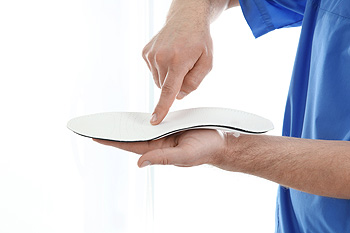 Orthotics are special, custom-made foot or heel inserts that are normally prescribed by a podiatrist to help treat foot, leg, or back issues. You may need orthotics if you are experiencing foot deformities, need assistance in the overall function of the foot, are seeking support for your ankle, or you are trying to reduce the risk of other foot related injuries. Orthotics help to treat a number of issues concerning the feet such as arthritis, bunions, hammertoes, flat feet, heel spurs, and plantar fasciitis. If you have any of these conditions or are experiencing foot pain, we recommend you seek the assistance of a podiatrist for a proper diagnosis, and to see if orthotics are the best treatment option for your discomfort.
Orthotics are special, custom-made foot or heel inserts that are normally prescribed by a podiatrist to help treat foot, leg, or back issues. You may need orthotics if you are experiencing foot deformities, need assistance in the overall function of the foot, are seeking support for your ankle, or you are trying to reduce the risk of other foot related injuries. Orthotics help to treat a number of issues concerning the feet such as arthritis, bunions, hammertoes, flat feet, heel spurs, and plantar fasciitis. If you have any of these conditions or are experiencing foot pain, we recommend you seek the assistance of a podiatrist for a proper diagnosis, and to see if orthotics are the best treatment option for your discomfort.
If you are having discomfort in your feet and would like to try orthotics, contact Dr. Lee R. Stein from Lake Shore Foot & Ankle, PC. Our doctor can provide the care you need to keep you pain-free and on your feet.
What Are Orthotics?
Orthotics are inserts you can place into your shoes to help with a variety of foot problems such as flat feet or foot pain. Orthotics provide relief and comfort for minor foot and heel pain but can’t correct serious biomechanical problems in your feet.
Over-the-Counter Inserts
Orthotics come in a wide variety of over-the-counter inserts that are used to treat foot pain, heel pain, and minor problems. For example, arch supports can be inserted into your shoes to help correct overarched or flat feet, while gel insoles are often used because they provide comfort and relief from foot and heel pain by alleviating pressure.
Prescription Orthotics
If over-the-counter inserts don’t work for you or if you have a more severe foot concern, it is possible to have your podiatrist prescribe custom orthotics. These high-quality inserts are designed to treat problems such as abnormal motion, plantar fasciitis, and severe forms of heel pain. They can even be used to help patients suffering from diabetes by treating foot ulcers and painful calluses and are usually molded to your feet individually, which allows them to provide full support and comfort.
If you are experiencing minor to severe foot or heel pain, it’s recommended to speak with your podiatrist about the possibilities of using orthotics. A podiatrist can determine which type of orthotic is right for you and allow you to take the first steps towards being pain-free.
If you have any questions please contact one of our offices located in Chicago, Highland Park, and Uptown, IL . We offer the newest diagnostic and treatment technologies for all your foot and ankle needs.
Blog Archives
- April 2025
- March 2025
- February 2025
- January 2025
- December 2024
- November 2024
- October 2024
- September 2024
- August 2024
- July 2024
- June 2024
- May 2024
- April 2024
- March 2024
- February 2024
- January 2024
- December 2023
- November 2023
- October 2023
- September 2023
- August 2023
- July 2023
- June 2023
- May 2023
- April 2023
- March 2023
- February 2023
- January 2023
- December 2022
- November 2022
- October 2022
- September 2022
- August 2022
- July 2022
- June 2022
- May 2022
- April 2022
- March 2022
- February 2022
- January 2022
- December 2021
- November 2021
- October 2021
- September 2021
- August 2021
- July 2021
- June 2021
- May 2021
- April 2021
- March 2021
- February 2021
- January 2021
- December 2020
- November 2020
- October 2020
- September 2020
- August 2020
- July 2020
- June 2020
- May 2020
- April 2020
- March 2020
- February 2020
- January 2020
- December 2019
- November 2019
- October 2019
- September 2019
- August 2019
- July 2019
- June 2019
- May 2019
- April 2019
- March 2019
- February 2019
- January 2019
- December 2018
- November 2018
- October 2018
- September 2018
- August 2018
- July 2018



